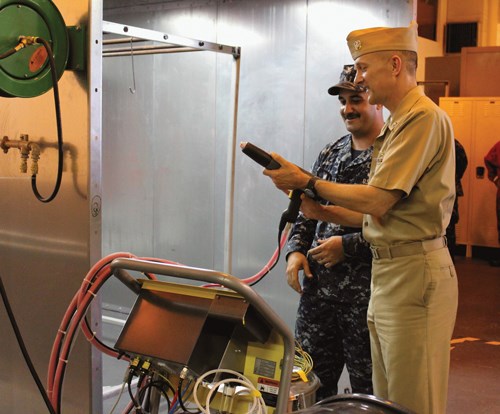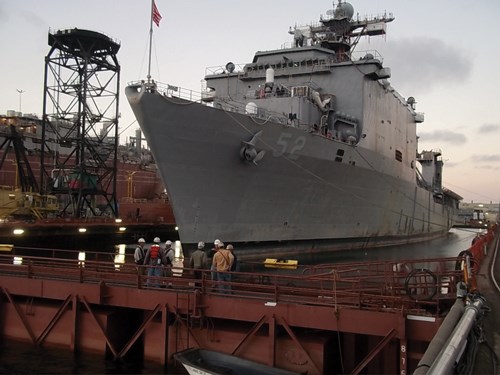Ask Akzo Nobel representative Dave Elmore how much powder coating is going into the construction of the Navy’s newest aircraft carrier, the U.S.S. Gerald R. Ford, and you’ll get a smile and a smart answer.
“A boatload,” says Elmore, who works with the ship’s general contractor Huntington Ingalls Industries on their powder coating needs. “And I couldn’t be happier about it.”
When the Gerald R. Ford (CVN 78) gets sent out to sea from its dry dock at the Newport News, Va., shipyards in 2015, it will probably have more powder coating in it than any other vessel in the U.S. Navy.
With the military increasing its use of powder-based coatings to cover vehicles, equipment and ships—the Army has recently announced that it will allow the use of powder coatings in its CARC coverings that are normally e-coated—more assets are getting the powder coating treatment than ever before, much to the joy of the powder manufacturers.
Developing powder coating processes
“The U.S. Navy has been actively involved in powder coatings for decades and, working cooperatively with industry, has developed a number of unique powder coating processes,” says Mark Ingle, the Naval Sea Systems Command’s technical warrant holder for coatings.
“Powder coatings are currently performing extremely well on surface ship louvers,” he says. “Carriers do not have these kinds of louvers, but the point is the Navy is a consumer of powder coatings, and these coatings help to reduce total ownership costs.”
TOC—total ownership cost—is the big catchword being tossed around by all military branches these days, especially when top generals and admirals have instructed their staffs to find ways to reduce the billions of dollars spent of corrosion repair, repainting and general overall maintenance of the U.S. military’s thousands of vehicles and ships.
$23 billion in corrosion
In 2010, the Department of Defense estimated that corrosion costs it more than $23 billion annually.
While it has fewer assets to protect, the Navy has not been immune from paying big bucks in fighting corrosion costs: about 25 cents of every maintenance dollar the Navy spends. And the annual corrosion cost for Navy ships is estimated to be $3.7 billion annually.
The U.S. Congress even got involved, enacting several legislative requirements to address the high cost of corrosion on military equipment and infrastructure, including legislation that created the Office of Corrosion Policy and Oversight (called the “Corrosion Office”) within the Office of the Under Secretary of Defense for Acquisition, Technology and Logistics. The Corrosion Office is responsible for the prevention and mitigation of corrosion of military equipment and infrastructure and, according to officials, manages funding for DOD-wide corrosion prevention and control (CPC) activities, and CPC projects proposed by the military departments.
A big part of the corrosion and maintenance reduction will be the use of coatings that provide improved wear and hold up better to the rigorous weather at sea, which is why the Navy has undertaken extensive studies on the use of powder coatings.
Powder’s environmental advantage
At a conference of “Strategic Environmental Research and Development Program” consultants—the DoD’s environmental science and technology program— Christopher Geib with Science Applications International Corp. presented that powder coating also had an environmental advantage over current wet paint applications used by the military branches, as well as improved corrosion resistance.
Geib said the thinking has changed that powder coating needs a high-processing temperature (675°F) and that corrosion resistance was lost once barrier protection was compromised. Coatings can now be applied that cure at 250°F within 30 minutes, he says.
“Today’s material eliminates these limitations,” Geib says of the current powder coating technology.
The improvements in powder coatings over the last decade moved the Navy to re-open the Norfolk Ship Support Activity’s powder coating facility at Norfolk Naval Station last July 1, re-establishing the capability to apply corrosion resistant, powder-based paint to shipboard equipment on Norfolk-based ships.
Navy reopens powder coating shop
Originally closed in the mid-90s when the Norfolk Regional Repair Center was moved to the Norfolk Naval Shipyard, the powder coating facility was re-established to make this corrosion control capability more accessible to surface ships.
“With corrosion a relentless adversary, this new powder coating shop will help reduce maintenance costs and provide a much needed asset for our surface ships,” says Rear Adm. Dave Thomas, Commander, U.S. Navy Surface Forces, Atlantic, who participated in the re-establishment ceremony. “We've waited 16 years to get our intermediate maintenance facilities back on line, and I’m delighted we’re growing these capabilities, one step at a time."
With 73 percent of the Navy’s 313-ship fleet already built and in use, repairs and recoats are the major areas where powder coating comes into play.
When ships come in for repairs, old paint is sandblasted from parts in the Navy’s blast-off booth prior to being given a fresh coating in the powder-coat spray booth. Afterwards, they are placed in bake-on ovens to seal the powder coatings.
Reducing ship corrosion
“By using powder coating, sailors are able to reduce surface ship corrosion on a great variety of parts throughout an entire ship,” Norfolk Ship Support Activity Production Manager Ronnie Saunders says. “Powder coating works especially well for the environments our ships face at sea. The coatings are weather resistant, making parts more anti-corrosive than other coverings, and they are environmentally friendly.”
In addition, this past summer Vice Adm. Kevin McCoy, the commander of the Naval Sea Systems Command, opened the new Navy Regional Maintenance Center in Norfolk to oversee surface ship maintenance and modernization, including adding new corrosion-prevention coatings.
“Over the past several months my staff has been working diligently with the fleet and type commanders, NAVSEA, RMCs and contractors to align our efforts and focus in on the harder issues surrounding sustaining our surface fleet,” NRMC Commander Rear Adm. David J. Gale says.
18 colors on one ship
Akzo Nobel’s Elmore—a former midshipman himself—says he is working with the Navy on all types of applications in ships and vessels, including the humongous U.S.S. Gerald Ford.
“You name it and we’re powder coating it,” Elmore says. “It’s not the hulls, but it’s the fixtures, the doors, the equipment, the pipes and anything else that could withstand more than 5,000 people a day using it.”
Elmore says meeting the Navy’s very strict standards and specifications was a challenge, such as meeting the need for as much as 18 different colors of coatings.
“Everything is color-coded inside the ship, and it needs to be for anyone to get around such a large place,” he says. “It’s a challenge, but so is everything we do. Going in you may have thought all you needed was a drab green color, but it’s been fun working on these projects because the finished product is magnificent.”
For information on Akzo Nobel, please call 866-745-8815 or visit pfonline.com/suppliers/akzo.
Axalta Coating Systems














.jpg;maxWidth=300;quality=90)







